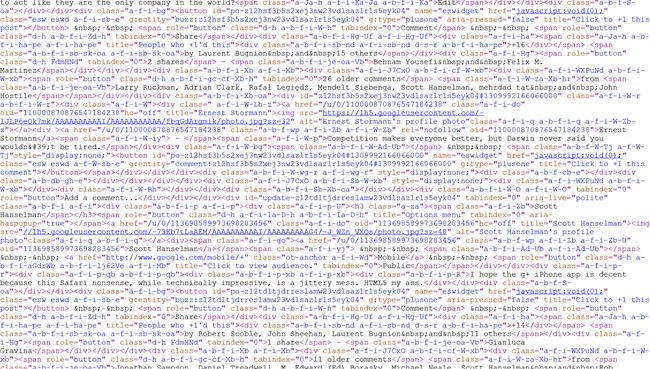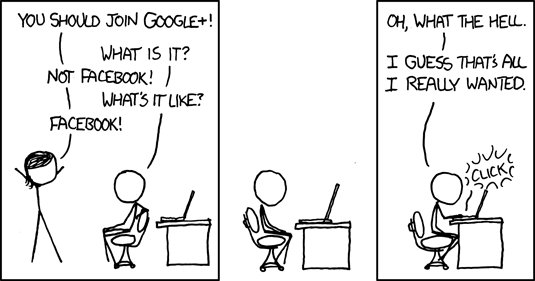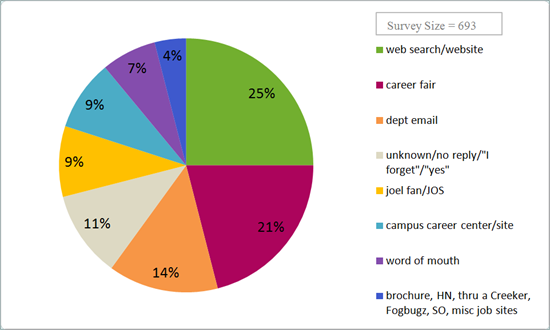JavaScript is Assembly Language for the Web: Sematic Markup is Dead! Clean vs. Machine-coded HTML
UPDATE: Some folks think that saying "JavaScript is Assembly Language for the Web" is a totally insane statement. So, I asked a few JavaScript gurus like Brendan Eich (the inventor of JavaScript) and Douglas Crockford (inventor of JSON) and Mike Shaver (Technical VP at Mozilla). Their comments are over in this follow up blog post.
I was talking to Erik Meijer yesterday and he said:
JavaScript is an assembly language. The JavaScript + HTML generate is like a .NET assembly. The browser can execute it, but no human should really care what’s there. - Erik Meijer
This discussion started because I was playing with Google+ and, as with most websites that I'm impressed with, I immediately did a View Source to see what was underneath. I was surprised. I saw this:
Let's just say that this went on for about 1300 lines. It is tight and about 90k. This is just the first half. It's mostly minified JavaScript. The middle part of the page is all spans and divs and generated class ids like this:
Oy. The whole page is a big GUID.
However, I see this on http://msn.com, http://www.bing.com, http://www.facebook.com and on and on. Even http://www.twitter.com is starting to "tighten" up a bit. All large sites appear to care not one bit about the aesthetics of their markup. So why do we?
It works, and it works great. Many of Google's best properties have GWT behind them. Would you be more impressed if you did a View Source and found that it was not only pretty on the outside but also inside?
This seems a little ironic because it was just a few years ago when ASP.NET Developers were railing against ViewState. "It's so heavy" really means "I don't understand what it does." ViewState was (and is) a powerful enabler for a development methodology that gets folks developing on the web faster than before. This is not unlike other toolkits Google Web Toolkit (GWT). GWT isn't completely unlike Web Forms in its philosophy. From the GWT website:
Google Web Toolkit (GWT) is a development toolkit for building and optimizing complex browser-based applications. Its goal is to enable productive development of high-performance web applications without the developer having to be an expert in browser quirks, XMLHttpRequest, and JavaScript.
That seems like a very admirable philosophy, no? You could even say (with apologizes and tongue in cheek):
"ASP.NET WebForms" is a development toolkit for building and optimizing complex browser-based applications. Its goal is to enable productive development of high-performance web applications without the developer having to be an expert in browser quirks, XMLHttpRequest, and JavaScript.
The intent of this post isn't to shine a light on WebForms or be a WebForms apologist. It's great for certain kinds of apps, just as GWT is great for certain types of of apps. What I want to focus on is that working with server-side toolkits could be argued as going against the alternate philosophy that the real joy of developing on the new web comes from clean jQuery JavaScript and clean, clear markup ala Razor or HAML. It all comes down to what level of abstraction you choose to play at.
Semantic markup will still be buried in there and things like http://schema.org are still very important, just don't expect the source of your favorite website to read like a well indented haiku anymore.
To be clear, minification and compression are orthogonal optimizations. I'm talking about simply not caring if the markup and script emitted to the client are pretty. If you don't care about the markup sent to the browser, only the result, how can this free us to develop in new ways that aren't confined to slinging markup and JS. Ultimately, if it works great, who cares?
My question to you, Dear Reader, is why do you care what View Source looks like? Is HTML5 and JavaScript the new assembly language for the Web?
UPDATE for clarity:
The point is, of course, that no analogy is perfect. Of course JavaScript as a language doesn't look or act like ASM. But as an analogy, it holds up.
- JavaScript is ubiquitous.
- It's fast and getting faster.
- Javascript is as low-level as a web programming language goes.
- You can craft it manually or you can target it by compiling from another language.
If the tools - as a developer OR a designer - give you the control and the results you want, what do you care? I propose that neither Rails, nor ASP.NET nor GWT is 100% there. Each has their issues, but I think the future of the web is a diminished focus on clean markup and instead a focus on on compelling user experiences combined with languages and tools that make the developers work enjoyable and productive.
What do you think, Dear Reader...Do you want your HTML and JavaScript abstracted away more? Or less?
UPDATE: I want to say this again to make sure folks really understand. There's two separate issues here. There's minification and general obfuscation of source, sure. But that's just the first. The real issue is JavaScript as a target language for other languages. GWT is a framework for writing Web Applications in *JAVA* where the resulting bytecode is *JAVASCRIPT.* GWT chooses a high level designed language (Java) over an organicaly grown one (HTML+JS) and treats the whole browser as a VM. The question - do we write assembly language or something higher level? Also, I realize now that Google+ was written with Closure, but the point remains valid.
About Scott
Scott Hanselman is a former professor, former Chief Architect in finance, now speaker, consultant, father, diabetic, and Microsoft employee. He is a failed stand-up comic, a cornrower, and a book author.
About Newsletter








 or Zune
or Zune
_9a12330c-2264-49f0-8d29-bbd55f7ffb0a.png)
_3.png)

![p_IronJS[1] p_IronJS[1]](https://images.hanselman.com/blog/WindowsLiveWriter/HanselminutesPodcast271InsideIron.NETDLR_2B2/p_IronJS%5B1%5D_thumb.gif)
